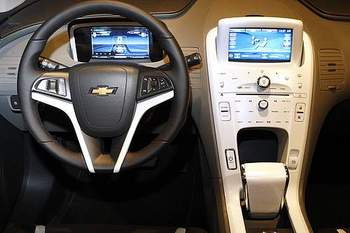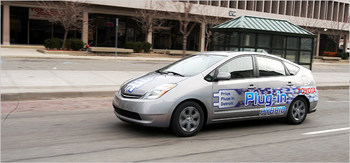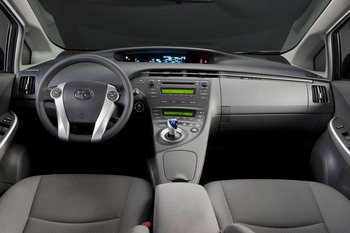There was big electric vehicle and hybrid news Tuesday, as General Motors stuck by their guns, but Toyota seems to be acknowledging that they expect sales of all their cars, including Prius, to slow for quite some time.
First, GM has announced the their "extended range hybrid EV" low emission/high mileage Chevrolet Volt will sell for $41,000 when it is introduced later this year --and that's just the base price.
We can be certain that in the great car dealer tradition, there will be a good amount of options available for the car (dealers make a lot of money on those extras and car-makers like to keep their dealers happy).
That $41K tab is in somewhat stark contrast to Nissan's recent announcement that their Leaf EV will cost under $33,000. That's an amount which, with federal, state and local incentives, might see its true base price drop to as low as near $25,500 after those credits are applied (the incentive amount all depends what state and municipality you're living in).
Former GM vice-chairman Bob Lutz introduces the first version of the Volt to be presented to the public at the Detroit Auto Show
So a base Volt, even given a buyer being able to take advantage of the full $7,500 federal incentive, and let's say $1,500 from the state and, perhaps, county or even city, will still tip the money scales at a price very near $32,000. And that's near the base price of Leaf before any incentives are applied.
But GM, apart from Volt's high technology, edgy styling and oh-my-gosh interior, will be depending on one main thing to draw buyers to Volt from less-expensive "pure electrics" (like Leaf and Mitsubishi's i-MiEV), and it's called "range anxiety."
It's a new term in the auto world, but it means just what it says: people driving cars which use any fuel other than gasoline worry about how far they can go without running out of that fuel.
Volt's gee-whiz interior, gauges and controls should impress buyers
Here's where Volt starts to sound like a great idea: While Nissan predicts a 100-mile range per charge-up for Leaf, GM says their car will have a range of around 600 miles per gasoline tankful, that gasoline powering an engine which keeps Volt's battery charged.
Volt will also have the ability to charge its battery by plugging into an electric outlet, so it appears an owner would have a tough time running out of range in Volt.
Most car-makers plan on their initial EVs being second or third commuter-type cars. And because the average American's round-trip work commute is said to be 40 miles or under, a 100-mile range should allay any range anxiety.
But Volt, at its price, size and features, is clearly being aimed at buyers as a primary family car. That $32K which an incentivized base-level Volt may actually cost, is right smack dab in the middle of the biggest part of the marketplace, where Taurus and Camry and Accord are located.
GM first called Volt an "extended-range hybrid" because Volt has a small on-board gasoline engine which is used to keep Volt's battery charged.
Because there is no direct connection between the gasoline engine and the electric drivetrain, GM decided they could legitimately call Volt an electric vehicle. It seems they've gotten their way even though in many minds the issue is still somewhat confused. GM has seen the media pick up on the EV claim (probably because "extended-range hybrid" is long and hard to explain in articles), making their EV claim, so far, successful.
Volt, which, with its small gasoline engine and electric motor and drivetrain, seems more-or-less an interim vehicle until GM comes up with their own pure EV and we'd love to see that product.
Now that we know more about Volt's price, it makes it easier to see where GM is aiming this new car and gives the competition some fodder when it comes to the cost of ownership.
Prius Won't Be Built in US
In addition to GM's pricing announcement for Volt, Toyota said on Tuesday that plans for building the Prius in the US, the car's biggest market, have been delayed.
Delayed for possibly as long as (get this) six years!
The Los Angeles Times reports that, "Toyota had intended to let a thousand Priuses bloom from its new Mississippi plant. The new plan is to wait until the car is remodeled and, more to the point, to wait until the global economy is a bit more sales-friendly."
Sure, but six years!?
Putting-off the Prius being built in the US is no big surprise; the very Mississippi plant where Toyota planned on putting these cars together has seen its own construction stop-and-start due to the worldwide recession and a very uncertain car market (last month, on June 17th, Toyota announced construction has resumed on the plant and the factory will produce Corollas starting in Fall, 2011).
Toyota's plug-in Prius has yet to become a reality
In May, 2008, Toyota announced sales of over 1,000,000 Prius gas/electric hybrids worldwide. Sales began in 1997 in Japan and in 2000 throughout much of the rest of the world. North America was by far the largest Prius market, with almost 600,000 of those initial million being sold here.
So slowing the ability to build those cars in the US shows Toyota's worries about the future; and not only their own future specifically, but that of the entire industry.
Beginning in the 1980's, the largest import car companies decided to "build 'em where we sell 'em" and in theory it was a good idea. It would cut all sorts of costs from building the vehicles and get them to markets much less expensively than shipping them across an ocean.
Car-makers went on a tear, opening plants all over the world (and experts say the average car-making plant costs about $1 billion).
In the US, import companies have set-up shop in what the industry calls "greenfield" areas of the country like Mississippi. But now they are seeing their rapid growth through the 1980's and '90s and early part of this century challenged by the realities of the worldwide economy. Interior of the new 2010 Prius
Interior of the new 2010 Prius
Greenfield describes, to car makers, an area low on jobs and as devoid of unions as much as possible, mostly in our nation's Southeast and Midwest. For instance, Toyota has plants in, among other places, Indiana and Texas, Honda is a major economic force in Ohio and Nissan builds many of the cars and trucks it sells in the US in Tennessee.
Some may remember that even Volkswagen had a plant (which they'd bought from Chrysler) in the US during those years in Pennsylvania which built their ill-fated pickup truck. The plant closed in 1987 but now they're coming back to build in the US --in Tennessee.
But many of these plants are now being seen possible future white elephants.
As the world gets greener, but the recession hangs on (and maybe comes back), even the building of the world's most popular low emissions/high mileage car has been put on hold in its largest market.